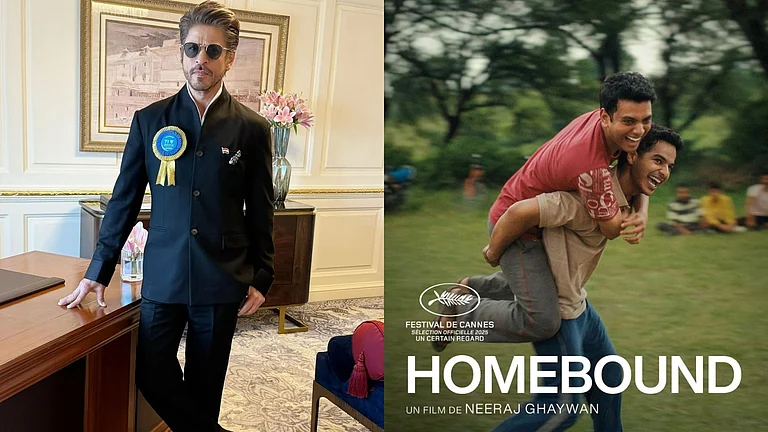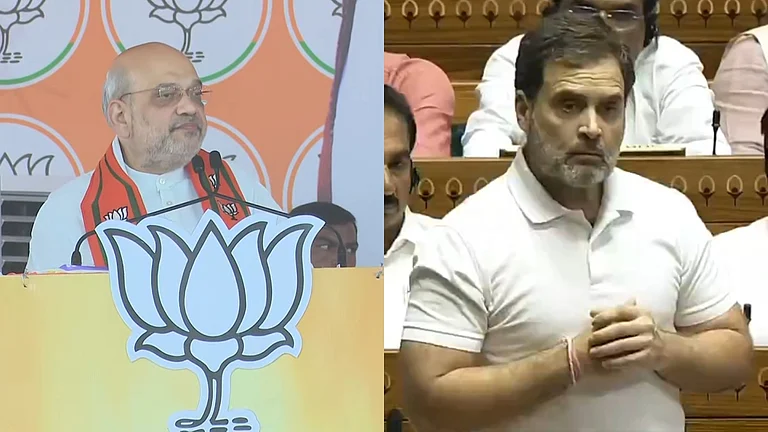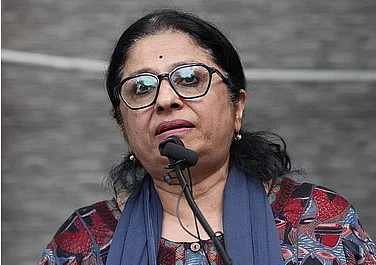In 2017, when some of the top designers and fashion editors of the world arrived at the London Fashion Week, they were met not by the usual swarm of models bound in frills and tassels but a crowd of nearly 250 angry activists. The latter were there to call out the luxe and flashy fashion world on its cruelty toward the planet, especially animals.
While the activists at the time were met with ridicule from fashion houses, fashion designers seem to have picked up on the trend of ‘eco couture’ – high fashion that doesn’t harm the planet or those living on it. And an example of such fashion was seen at the ongoing 22nd Lakme Fashion Week in Delhi when noted fashion designer JJ Valaya partnered up with Austrian textile giant Lenzing to create a traditional Indian couture line made entirely of ‘vegan silk’. The collection not only marked a shift in Valaya’s usual style which relies heavily on rich fabrics like Indian silks, brocade and embroidery work, but also brought back focus once again on responsible fashion.
Natural filament yarns have been the keyword in sustainable fashion for some time now. But not all such filament yarns that are seen as a sustainable alternative to other fabrics are cruelty free. For instance, some filament yarns, though natural, use animal fats for oiling as part of its manufacture process. Valaya’s collection is made of Tencel, the brainchild of Lenzing Group, a fabric created primarily from parts of trees. Lenzing’s Dr Pranesh Sridharan asserts that the fabric is 100 per cent vegan and claims it is the first filament yarn to have accreditation form international vegan societies. Tencel Luxe had also won the PETA award last year for being the best Vegan fabric. “It’s a great step for the fashion industry. It is not only cruelty free but also compostable and biodegradable” says a PETA representative. The organisation has for decades spearheaded the global fight against fur which later expanded to resisting all kinds of ‘cruel fashion’ such as leather, silk, wool and other products derived from animals.
But from being an organisation that got into trouble for its rabble-rousing ways (a PETA member once tried to attack a Canadian politician and the activists have pulled off several provocative fashion campaigns to call out animal cruelty) to being a promoter of ‘vegan silk’ at a fashion event may irk some. After all, the fashion industry itself is not known for kindness and while sustainability of fabrics may win designers brownie points, a fashion show in itself is no friend of the nature.
Couturier JJ Valaya agrees that learning about fabrics like Tencel makes him feel a little “guilty”. “The amount of heavy and luxury fabrics that we have used over the years, including silk, has been phenomenal… But I feel much of the fashion industry is soon going to adopt this new eco-friendly, accessible fabric,” Valaya says.
But even if it’s cruelty free, fabrics like Tencel come with their own problems. For instance, extraction of pulp from trees to create the cellulose-based fabric requires energy and leaves a fair bit of carbon trail (albeit less than artificial fabrics). While Lenzing itself claims to reuse over 90 per cent of the water used for producing the fabric, trees such as eucalyptus which are used to create it are irrigation intensive and require a lot of water. Sourcing of the trees is also a matter of environmental scrutiny.

So what really changes with Tencel Luxe? And do ordinary wearers care about the 2,500 mulberry silk worms killed to make one pound of silk? As it turns out, Gen Z, the new target audience for fashion houses, does. With ‘vegan’ becoming a buzzword and a lifestyle choice that has growing popularity among today’s ‘conscious’ youth, terms like ‘circular design’ and ’sustainable fashion’ are thrown about aplenty by any fashion house worth their salt.
“I would like to know that what I’m wearing was not once alive. I don’t want blood on my hands. But it needs to be affordable,” says Anuj, a 21-year-old fashion buff present at Dhyan Chand Stadium, the venue for LFW.
This is not the first time that Tencel has featured in the Lakme Fashion Week. Last year, Lenzing partnered with designers like Anita Dongre and Rajesh Pratap Singh. It has also partnered wit the retail chains like H&M, Zara and Levi’s and smaller outlets like ‘Door of Maai’ and has a considerable global presence. While the use of Tencel in fashion has existed for over a decade now, other brands are now jumping on the recycling and up-cycling bandwagon.
Last year, Reliance group’s R|Elan GreenGold fabric – made by recycling and reusing plastic waste –was a hit in the LFW. Several designers, such as Shivan & Narresh’s ‘Patu’ series and Alcis Sports and Narendra Kumar’s collaborative sports-wear series ‘My Earth My Style’, were among those who used the R|Elan Green Gold fibre for their showcase.
This year too, the LFW is focusing heavily on 'circular' fashion. LFW and Fashion Design Council of India inaugurated an event called ‘Circular Design Challenge’ on World Sustainability Day 2022 to encourage smaller fashion labels and entrepreneurs to create sustainable fashion from waste. Designers like the duo Shantanu and Nikhil and Varun Bahl went big on sustainability with the latter’s collection ‘Quintessential’ featuring up cycled embroidery. But while brands like Tencel, R|Elan and a growing consciousness for sustainability and carbon footprint of garments among both Indian fashion designers and consumers may bode well for nature and convince Gen Z influencers, fashion shows itself remain a sore thumb among environmental crusaders and fashion reformers.

And what indeed is sustainability? It's not merely using sustainable textiles or creating eco-friendly products. It involves increasing the ecological integrity of the fashion industry as a whole. Even if designers use sustainable materials to create a collection, the concept of fashion shows has often been questioned by environmental activists for promoting a culture of overproduction that in essence is against the tenet of sustainability built on longer shelf lives of products. The high carbon footprint of producing a 10-minute runway show including materials used for creating ramps and props, the food catering menu, the pollution caused by the to and fro movement of large groups of people across cities to attend such events, the massive electricity and water consumption at such events, all point to an environmentally unsustainable model.
The Fashion Month – which includes the four most influential fashion weeks in New York, Milan, Paris and London, is the source of 241,000 tonnes of carbon dioxide in a year. That is enough to power the Times Square in New York for 58 years, as per a report by Zero to Market.
The issue has been highlighted by international fashion councils and bodies as well as fashion houses and show organisers, many of whom are not only looking at alternative material for clothes but also at alternative models and policies for conducting such events. The idea of 'circular fashion', for instance, was born in 2018 after Helsinki Fashion Week pioneered the concept of 'eco villages' to reflect the circular relationship between fashion and local creators. The idea soon caught on. In 2020, the Copenhagen Fashion Week introduced a new ‘Action Plan’ that required all participating designers to follow 18 minimum environmental standards. It was also the year when the Fédération de la Haute Couture et de la Mode (FHCM) in Paris started providing transport services to guests including ferrying them in electric buses or zero carbon emission fuels.
Vegan Fashion Weeks have also become a hit among sustainable circuits. There were two held last year in Los Angeles organised by animal rights activist Emmanuelle Rienda. The show featured upcoming designers dedicated to using alternate materials like pineapple-leaf leathers, faux furs, and other fruit and natural based fibres. But sustainable alternatives like vegan silk, much like vegan food, require complex production processes and technological interventions that inevitably drive up the sale prices of such products. This raises the question – is sustainability in fashion cost prohibitive?
A 2020 survey by McKinsey & Company survey among European consumers found an increased interest and demand for sustainability. But while the study found 67 per cent consumers to prefer products made of eco-friendly materials, another study found that less than one third of consumers were willing to pay more for eco-friendly products. In India, surveys have shown a growing shift toward green products. An August 2020 report by Capgemini Research Institute found 79 per cent Indian consumers were making purchases based on their sustainability and inclusivity. A recent AC Nielson study also showed Indian consumers veering toward green and organic products. But several studies have repeatedly found a gap between willingness and actual purchase of the product at higher cost. In India where the markets are dominated by middle and lower middle income group consumers, the practicality and affordability of products is what ultimately decides its popularity.
Indian designers have slowly started making a shift toward sustainability in theory but much remains tethered to secluded acts and token gestures. Replacing silk with ‘vegan silk’ and up-cycling garbage to create clothing may be a start. But to truly turn fashion green, designers as well as fashion councils like the FDCI and giants like Lakme have to come together to find alternative (and fair) industry practices that ensure ethical trade standards – the backbone of conscious fashion – and create a culture of sustainability and affordable fashion that goes beyond 'luxe' faux fabrics and the complacent ‘vegan’ tag.


























